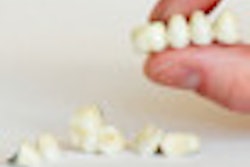
There are those days in dentistry when a clinician must undo what's been done because it simply did not work. The situation is common in restorative dentistry, and removing a resin composite material without leaving cracks, scarring, or scratches in the surrounding dentition is a challenge, particularly with rotary instruments.
Now, in an in vitro study, researchers from Kings College London Dental Institute at Guy's Hospital in the U.K. have compared two means of selectively removing resin composite material from an enamel analogue: with air abrasion using bioactive glass (BAG) or alumina (Applied Surface Science, March 12, 2014). The advantages of one clearly outweighed the other.
“BAG powder is more efficient than alumina in selective removal of resin composite.”
"BAG air abrasion was significantly more selective than alumina air abrasion in removing resin composite, supporting its clinical use in minimally invasive, tooth-preserving reparative dentistry," the researchers wrote.
They created their study based on previous research that determined that BAG powder, which contains 45 weight percent (wt%) silicon dioxide, 24.5 wt% sodium oxide, 24.4 wt% calcium oxide, and 6 wt% phosphorus pentoxide, can remove tooth structure that is softened, diseased, or weakened without significantly affecting healthy portions of the tooth (Journal of Dentistry, January 2011, Vol. 39:1, pp. 2-7). Additionally, other data gathered during an in vitro study comparing the air-abrasion materials for removing orthodontic adhesive cement showed that alumina produced more significant enamel damage than BAG (Operative Dentistry, January/February 2014, Vol. 39:1, pp. 81-89). And so the researchers of the current study applied a similar test to composite resin materials.
They broke their study down into three objectives:
- Learn more about BAG powder's chemistry and morphology
- Measure the effect of three clinically applicable variables: air pressure, powder flow rate (PFR), and type of abrasive powder
- Measure the time required for each procedure
Their null hypotheses were that there would be no difference in resin composite removal, air pressure and PFR setting would have no effect on both powders, and there would be no difference in time requirements. All three were rejected.
First, the researchers confirmed the makeup of the BAG 45S5 abrasive powder (Sylc, OSspray) and alumina powder (Aquacut, Velopex) powders with scanning electron microscopy energy-dispersive x-ray spectrometry and laser diffraction particle analysis; resin composite removal tests came next.
They utilized an Aquacut air-abrasion unit (Velopex) with a circular cross-section nozzle due in part to its ability to independently control air pressure and PFR. Each clinically adjustable air pressure value (40, 60, and 80 psi) had three different tested PFR dial settings of 1, 3, and 5 (the lowest, midpoint, and highest setting, respectively), resulting in a total of nine experimental groups.
After creating rounded cavities with a 3-mm diameter and 0.7-mm depth in a Macor (Corning) sheet, they were filled with Filtek Supreme Ultra (3M ESPE) of a contrasting shade and light-cured. Next, they removed the resin composite under the conditions of each group (n = 5), rinsed, dried, and examined the sample with 2.5x magnification loupes and noncontact laser profilometry to obtain comparable 3D images.
The researchers found that BAG powder removed significantly less Macor material than alumina (p < 0.001) and that air pressure and PFR settings had a statistically significant (p < 0.001) impact on the volume of Macor material lost in both powders. It also impacted removal selectivity.
With a PFR setting of 1 and 60 psi, the alumina and BAG groups removed 3.5 ± 1.2 mm3 and 3.0 ± 1.1 mm3 (mean ± standard deviation) Macor volume, respectively. But when the air pressure was increased to 80 psi under the same PFR setting, the amount of Macor removed jumped to 5.3 ± 1.5 mm3, while BAG's volume removal only increased to 3.7 ± 0.7 mm3.
The researchers found significant differences in Macor volume removal for different PFR settings coupled with 60 psi for alumina and 60 and 80 psi for BAG (p < 0.001), while none were observed for either at 40 psi.
So where did they find the most potentially harmful results? The most unnecessary Macor removal occurred for both powders at settings of 80 psi and PFR settings of 3 and 5 (p < 0.001). With 80 psi air pressure and a PFR setting of 3, alumina had an "undesirable" removal total of 7.1 ± 2 mm3, while 80 psi air pressure and a 5 PFR setting removed 6.7 ± 1.2 mm3. Consequently, the researchers warned against using too much of either material.
But they also found that using a low PRF setting with low pressure also increased the volume of Macor substrate removed. Perhaps, the researchers suggested, the operator compensated for the low flow and low power by applying the air-abrasion nozzle to each area for more time, resulting in "overpreparation."
Alumina did remove resin composite material more quickly (p < 0.001) but with wide standard deviations, the researchers noted. However, it does not offer the potential for remineralization that BAG powder has, since it forms hydroxycarbonate apatite when it interacts with an aqueous solution. Overall, the greater time required for BAG powder was viewed as a negligible trade-off by the researchers, given its superior performance in other areas.
"BAG powder is more efficient than alumina in selective removal of resin composite particularly under specific operating parameters, and therefore may be recommended clinically as a method of preserving sound enamel structure when repairing and removing defective resin composite restorations," they concluded.



















